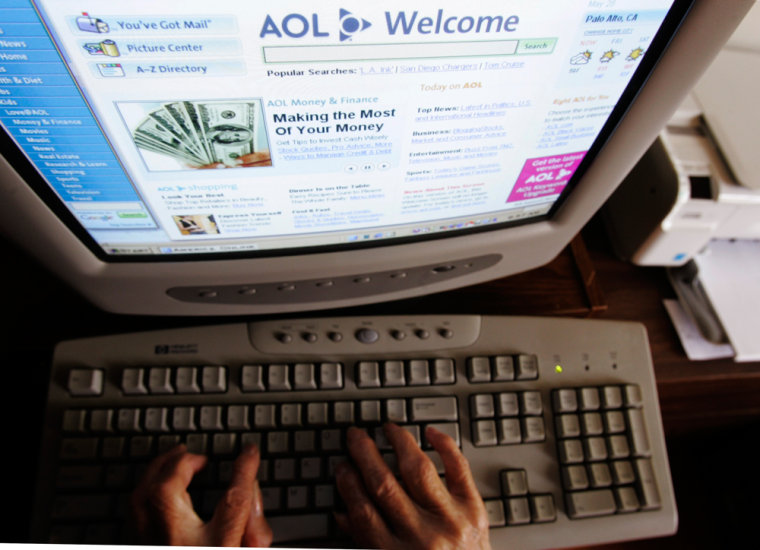AOL is shaking loose from Time Warner Inc. and heading into the next decade the way it began this one, as an independent company. Unlike the 1990s, though, when AOL got rich selling dial-up Internet access, it starts the 2010s as an underdog, trying to beef up its Web sites and grab more advertising revenue.
Despite a few bright spots in its portfolio of sites, such as tech blog Engadget, AOL has a long way to go until Web advertising can replace the revenue it still gets from selling dial-up Internet access. One especially popular property, entertainment site TMZ, is a joint venture with a Time Warner unit that will keep TMZ after AOL splits off.
This week, investors will get a chance to place bets on AOL. On Wednesday, Time Warner shareholders as of Nov. 27 will get one share of AOL for every 11 of their Time Warner shares. The next morning, AOL CEO Tim Armstrong is set to ring the opening bell at the New York Stock Exchange, and AOL will begin trading under the ticker symbol of the same name — the very one it had as a dot-com era darling that used $147 billion worth of its inflated stock to buy Time Warner in 2001.
The parent company was even known as AOL Time Warner in AOL's heyday. At the time, Time Warner thought its movie, TV and magazine content would benefit from ties with AOL's Internet access business. The media conglomerate announced AOL's spinoff in May after years of trying unsuccessfully to integrate the two companies.
AOL will initially be worth about $2.5 billion. That's based on Thursday's close of $24.07 for preliminary AOL shares, which investors can begin trading ahead of the formal spinoff this week, and on a November regulatory filing in which AOL predicted it would start with about 105.7 million shares. AOL will have no debt.
In the past year, AOL hired Armstrong, a former Google advertising executive, to engineer a turnaround that eluded the company while it was part of Time Warner.
Fewer dial-up customers
In those years, AOL struggled to complete its transition away from relying on its dial-up business. The service peaked in 2002 with 26.7 million subscribers, and has declined steadily as consumers switched to broadband. In the third quarter, AOL had 5.4 million dial-up subscribers, who paid an average of $18.54 per month.
Even with the decline, this business brought in $332 million during the quarter, or 43 percent of AOL's total revenue. But that's down from $1.8 billion, or 82 percent of revenue, during its peak quarter seven years earlier.
AOL has tried to offset the fading service by moving away from its origins as a "walled garden" with subscriber-only content to a network of online destinations with free material, supported by ads. AOL even began giving away AOL.com e-mail accounts.
The results have been mixed. AOL's ad revenue increased 18 percent to $2.23 billion in 2007, but then it dropped to $2.10 billion in 2008 and has fallen in each of the first three quarters of this year. AOL's advertising shortfall in the third quarter — an 18 percent decline from the same period a year ago — was much worse than the 5.4 percent drop in overall Web ad market, according to PricewaterhouseCoopers LLP.
Another problem: AOL's more than 80 Web sites are struggling to keep their viewers. In the third quarter, AOL's network had 102 million unique visitors in the U.S., according to comScore, a 7 percent drop from 110 million a year ago. By contrast, Google and Yahoo both showed gains of more than 10 percent.
AOL has responded partly with plans to shed up to 2,500 jobs, or more than a third of its employees, in an effort to save $300 million a year. That comes on top of thousands of other cuts in recent years and will leave the company at less than a quarter the size it was at its peak in 2004.
Focus on content
AOL also is trying to produce online material far more cheaply. It plans to launch dozens of new sites next year and populate much of them with work done by freelancers. These freelancers will be paid by the post — some with a flat rate, some with a share of revenue based on the amount of traffic the post generates.
Ned May, an analyst with Outsell Inc., believes AOL can use this low-cost method to experiment with building lots of new sites and see what sticks with viewers.
To stimulate the process, AOL is counting on a content-management system it calls Seed. It shows information about the kinds of things people are searching for online so that writers and editors can quickly create material people presumably want to read.
For example, a site might traditionally write about Halloween costumes in mid-September, but search data showed that people were looking for costumes in August, said Bill Wilson, AOL's head of media.
"There was this whole window we were missing," Wilson said.
Gabelli & Co. analyst Christopher Marangi believes AOL will have to figure out how to better integrate social networking into its sites. AOL owns a social site called Bebo, which is popular overseas but gets about 6 percent as many visitors as Facebook does in the U.S., according to comScore data.
Being its own company again means AOL will regain the freedom to use its resources solely for its own benefit, rather than worrying about how they fit into the Time Warner empire. If the stock performs well, it could become a currency AOL can use to snag employees and acquire other companies.
Of course, now the world also will be able to more closely follow whether AOL is making progress on its strategy.
"That may be a challenge," Armstrong said, "but I think it's a challenge we knew we were signing up for whether we were public or private."
